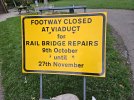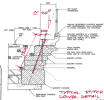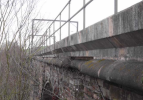If you study civil engineering your degree course will hardly mention masonry arches at all, so even well qualified engineers nowadays use the term 'parapet' fairly loosely. But my interpretation is that on a masonry bridge or viaduct a parapet is a non-loadbearing wall or barrier.
Many masonry arch railway bridges and viaducts were built without parapet walls and had railings or other barriers added at a later date. From the photos posted on this thread, it looks to me that Plessey viaduct is one of those. So I would not describe the part of the structure which has collapsed as a parapet. To me it's part of the spandrel wall, which supports the backfill above the arch(es) right up to track level, so definitely is structural and loadbearing.



